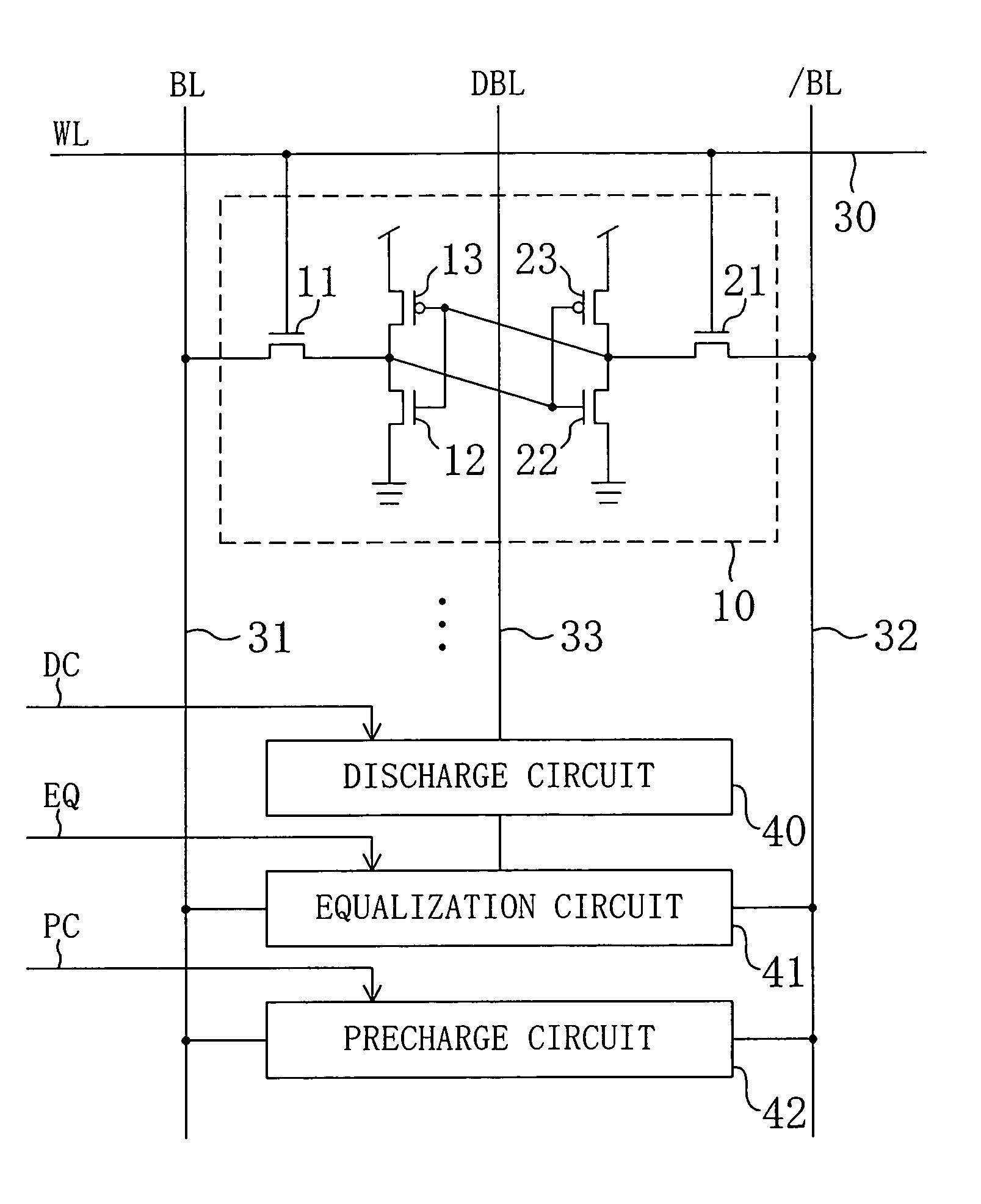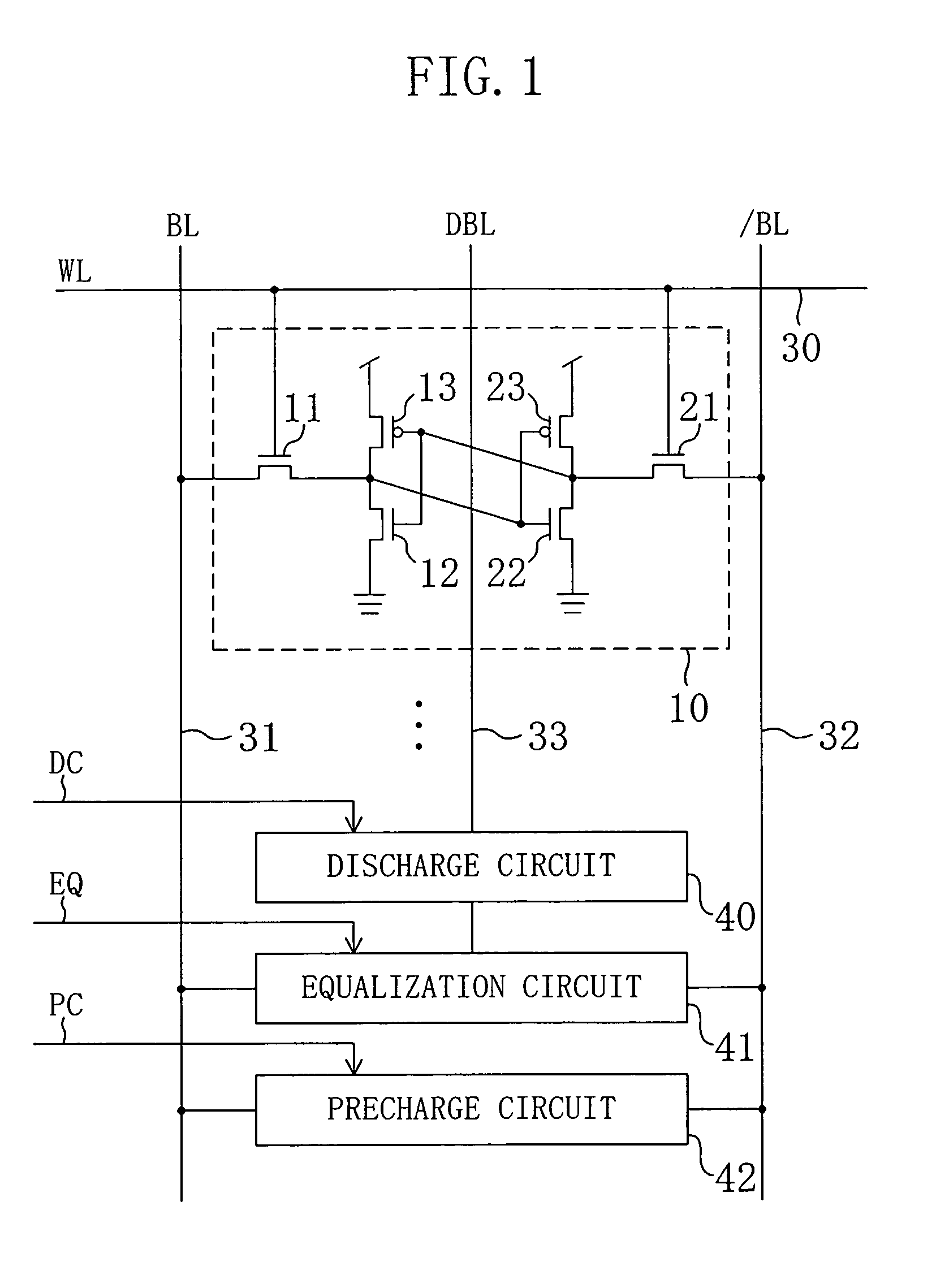Semiconductor memory device
a memory device and semiconductor technology, applied in semiconductor devices, digital storage, instruments, etc., can solve the problems of small capacitance, large yield drop, and low yield, so as to reduce the voltage on the word line, static noise margin, and voltage at a low-potential memory node.
- Summary
- Abstract
- Description
- Claims
- Application Information
AI Technical Summary
Benefits of technology
Problems solved by technology
Method used
Image
Examples
embodiment 1
[0027]FIG. 1 shows a configuration of a semiconductor memory device according to a first embodiment of the present invention. In FIG. 1, a memory cell 10 is a six-transistor memory cell including: a pair of NMOS access transistors 11 and 21; a pair of NMOS drive transistors 12 and 22; and a pair of PMOS load transistors 13 and 23. Reference numeral 30 denotes a word line (WL), reference numerals 31 and 32 denote a pair of bit lines (BL and / BL), reference numeral 33 denotes a dummy bit line (DBL), reference numeral 40 denotes a discharge circuit, reference numeral 41 denotes an equalization circuit and reference numeral 42 denotes a precharge circuit. The memory cell 10 is connected to the word line 30 and the pair of bit lines 31 and 32. The discharge circuit 40 is connected to the dummy bit line 33 and receives a discharge control signal DC. The equalization circuit 41 is connected to the pair of bit lines 31 and 32 and the dummy bit line 33 and receives an equalization control si...
embodiment 2
[0037]FIG. 6 shows a configuration of a semiconductor memory device according to a second embodiment of the present invention. The configuration shown in FIG. 6 is different from that of the first embodiment in that a PMOS transistor, for example, is provided as a transistor 43 for electrically dividing a dummy bit line (DBL) 33 into two when a dummy-bit-line adjustment signal DA is at an H level. The other part of the configuration is the same as that of the first embodiment.
[0038]FIG. 7 shows read operation of the semiconductor memory device shown in FIG. 6. According to FIG. 7, when the dummy-bit-line adjustment signal DA is at an L level and the PMOS transistor 43 is activated, the operation is the same as in the first embodiment. On the other hand, when the dummy-bit-line adjustment signal DA is at an H level and the PMOS transistor 43 is inactivated, a small amount of charge moves during equalization in a period T2, so that it is possible to reduce voltage drops on a pair of b...
embodiment 3
[0042]FIG. 8 shows a configuration of a semiconductor memory device according to a third embodiment of the present invention. In the configuration shown in FIG. 8, the discharge circuit 40 of the first embodiment is constituted by a PMOS transistor 44 for drawing charge from a dummy bit line (DBL) 33. A discharge circuit 40 according to this embodiment discharges the dummy bit line 33 to a threshold voltage Vt of the PMOS transistor 44 when a discharge control signal DC is at an L level. Reference sign SC denotes a substrate potential control signal for changing a substrate potential of the PMOS transistor 44. The other part of the configuration is the same as in the first embodiment.
[0043]FIG. 9 shows read operation of the semiconductor memory device shown in FIG. 8. According to the configuration shown in FIG. 8, the threshold voltage Vt of the PMOS transistor 44 is changed with the substrate potential control signal SC. For example, if the threshold voltage Vt is zero (Vt=0), the...
PUM
 Login to View More
Login to View More Abstract
Description
Claims
Application Information
 Login to View More
Login to View More - R&D
- Intellectual Property
- Life Sciences
- Materials
- Tech Scout
- Unparalleled Data Quality
- Higher Quality Content
- 60% Fewer Hallucinations
Browse by: Latest US Patents, China's latest patents, Technical Efficacy Thesaurus, Application Domain, Technology Topic, Popular Technical Reports.
© 2025 PatSnap. All rights reserved.Legal|Privacy policy|Modern Slavery Act Transparency Statement|Sitemap|About US| Contact US: help@patsnap.com



